You’re paying more for electricity than you need to, and your home’s energy usage is completely out of your control. Most homeowners waste 20-30% of their energy without realizing it, watching their monthly bills climb while missing simple opportunities to cut costs. A smart home energy command center changes this entirely by giving you real-time visibility and automated control over every watt flowing through your house. The setup process, however, isn’t as straightforward as you might expect.
Understanding Energy Command Centers and Their Benefits
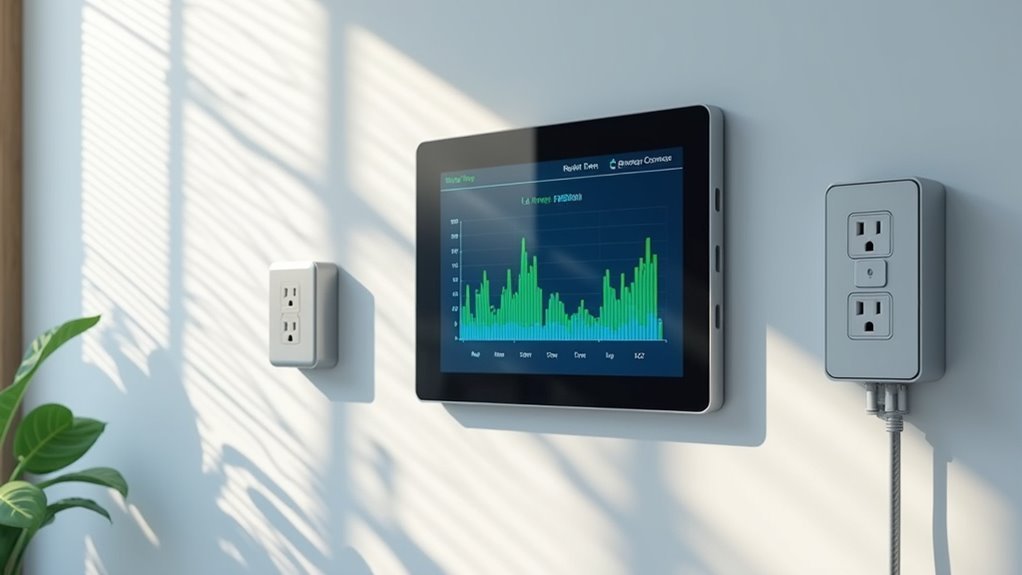
When you’re looking to take control of your home’s energy consumption, an energy command center serves as the brain of your smart home ecosystem. This integrated system connects smart devices and monitoring tools to provide real-time insights into how you’re using energy throughout your home.
You’ll gain central control over heating, cooling, and lighting systems, allowing you to optimize energy usage based on your daily routines and preferences.
The benefits extend beyond convenience. By tracking consumption patterns and making informed adjustments, you can achieve significant financial savings—potentially reducing heating and cooling costs by 15% or more.
Your energy command center also enhances comfort through automation while supporting environmental sustainability through reduced energy waste.
Assessing Your Home’s Current Energy Infrastructure
Before implementing your energy command center, you’ll need to examine your home’s existing energy setup to identify opportunities for improvement and potential obstacles.
Start by evaluating your current appliances’ energy efficiency ratings, as older models consume considerably more power than modern equivalents. Conduct an energy audit to locate drafty windows and poor insulation that drive up heating and cooling costs.
Check whether outdated wiring can support modern smart devices like smart thermostats and monitoring systems.
Utilize smart energy monitoring tools such as eMonitor to analyze your energy consumption patterns and identify high-usage areas.
These upgrades offer substantial savings—LED lighting reduces consumption by 75%, while smart thermostats cut heating and cooling costs by 15% annually.
Selecting the Right Smart Hub for Energy Management
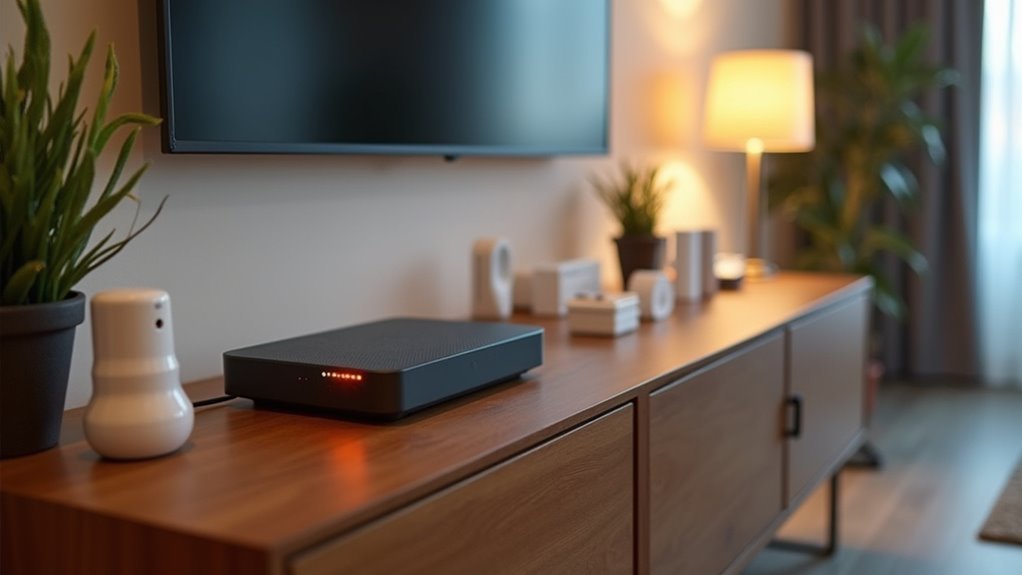
You’ll need to evaluate how well potential smart hubs work with your existing energy devices and any future additions you’re planning.
Start by checking compatibility with your current smart thermostats, plugs, and monitoring systems to guarantee seamless integration.
Focus on hubs that offer extensive energy tracking features, as these’ll give you the data needed to optimize your home’s energy consumption.
Hub Compatibility Assessment
How can you guarantee your smart home energy management system operates at peak efficiency? Start by conducting a thorough hub compatibility assessment. Your smart hub must seamlessly integrate with essential devices like smart thermostats, energy monitors, and smart plugs to optimize consumption effectively.
Verify your chosen hub supports key communication protocols such as Zigbee and Z-Wave, which enable robust device compatibility across your energy management network. Popular options like Amazon Echo, Google Nest Hub, and Apple HomeKit offer excellent integration capabilities.
Evaluate each hub’s energy management features, particularly its ability to create sophisticated automation scenes and provide real-time energy usage monitoring.
Research user reviews and technical specifications to identify which smart hub aligns best with your specific energy-saving objectives and existing device ecosystem requirements.
Energy Monitoring Features
Once you’ve established hub compatibility, the energy monitoring features become your primary tool for tracking and optimizing consumption patterns.
Your smart hub transforms into a centralized command center that collects detailed statistics from connected devices like smart thermostats and eMonitor systems. You’ll identify energy consumption trends and pinpoint areas where improvements are needed most.
The hub’s energy monitoring capabilities enable real-time tracking across all connected devices, giving you thorough insights into your home’s power usage.
Through automation features, you can create energy-saving routines that adjust based on occupancy patterns and usage data. This centralized approach simplifies management while maximizing efficiency and cost savings throughout your smart home ecosystem.
Essential Smart Devices for Energy Monitoring
You’ll need specific smart devices to transform your home into an efficient energy command center.
Smart energy monitoring systems like the eMonitor track your real-time consumption, while connected thermostats optimize your heating and cooling for maximum savings.
Automated power management devices, including smart plugs and LED lighting systems, give you granular control over individual appliances and can slash your energy usage by up to 75%.
Smart Energy Monitoring Systems
While traditional utility bills provide only monthly snapshots of energy consumption, smart energy monitoring systems like eMonitor deliver real-time insights that transform how you understand and control your home’s power usage.
These systems track every watt flowing through your electrical panel, revealing exactly which appliances consume the most electricity.
Smart plugs complement whole-home monitors by providing granular control over individual devices. You’ll identify energy hogs and discover surprising consumption patterns that monthly bills never reveal.
When integrated with Insteon-controlled thermostats, these systems can automatically optimize heating and cooling based on occupancy, potentially saving 15% or more on energy costs.
The real power emerges through centralized control within your smart home ecosystem, enabling sophisticated automation and energy-saving routines that respond intelligently to your lifestyle patterns.
Connected Thermostats and Controls
Because heating and cooling typically account for nearly half of your home’s energy consumption, connected thermostats represent the single most impactful upgrade you can make to your energy monitoring arsenal.
These intelligent devices learn your schedule and preferences to optimize heating and cooling automatically, delivering 15% or more in annual energy savings.
Quality models like the Nest cost under $150 and often qualify for utility rebates, making them excellent energy management investments.
You’ll gain remote control via smartphone apps, allowing temperature adjustments from anywhere.
Geofencing technology automatically detects when you’re home or away, adjusting settings accordingly.
When integrated with your monitoring system, connected thermostats provide real-time energy consumption data, empowering informed decisions about your home’s climate control efficiency.
Automated Power Management Devices
Smart plugs and automated outlets extend your energy monitoring capabilities beyond climate control to every device in your home.
These automated power management devices let you control and monitor energy consumption remotely through smartphone apps, delivering up to 10% reduction in monthly electricity usage from non-smart devices.
Your thorough power management strategy should include:
- Advanced smart plugs like Belkin WeMo Insight that offer power monitoring and scheduling features
- Energy-efficient smart LED bulbs reducing lighting consumption by 75% compared to incandescent bulbs
- Smart thermostats optimizing heating and cooling for 15% annual energy savings
- Real-time monitoring systems like eMonitor for tracking usage patterns
You’ll gain detailed insights into your energy consumption while automating usage patterns effectively, creating a truly intelligent energy command center.
Installing Smart Thermostats for Climate Control
Installing a smart thermostat represents one of the most impactful upgrades you can make to your home’s energy command center. These intelligent devices learn your daily routines and preferences, automatically optimizing temperature control for maximum comfort and energy efficiency. You’ll save up to 15% on your energy bills annually while enjoying enhanced convenience through remote control via smartphone apps.
| Feature | Benefit | Savings Potential |
|---|---|---|
| Learning Capabilities | Automatic schedule optimization | Up to 15% on energy bills |
| Remote Control | Smartphone app management | Flexible temperature adjustments |
| Geofencing Technology | Auto-adjust when away/returning | Reduced energy waste |
| Energy Reports | Usage pattern insights | Identify additional savings |
| Utility Rebates | Installation cost reduction | Lower upfront investment |
Smart thermostats transform your climate control into an intelligent, responsive system that works seamlessly within your energy management strategy.
Upgrading to Smart Lighting Systems
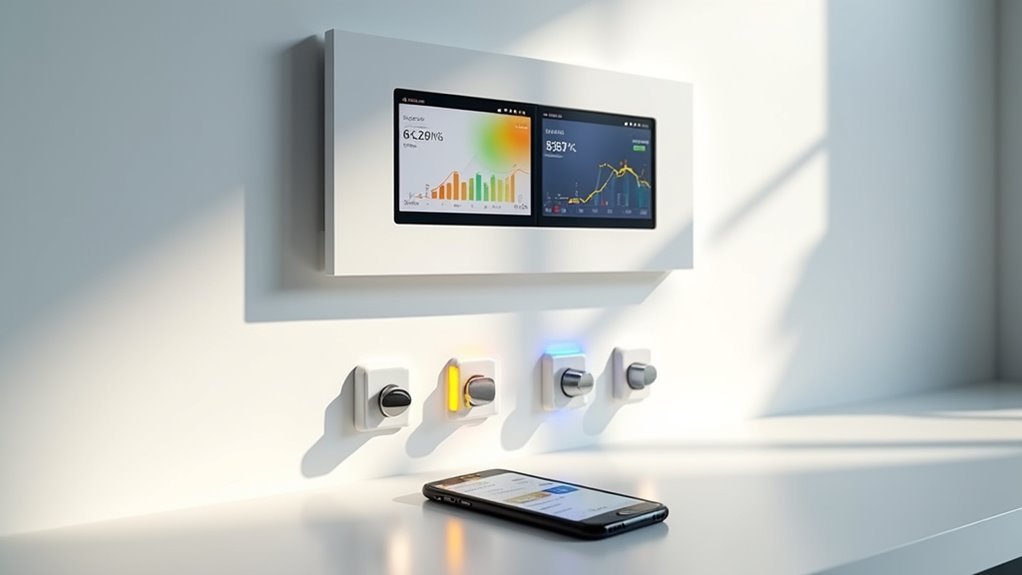
When you combine LED technology with intelligent automation features, smart lighting systems deliver extraordinary energy savings of up to 75% compared to traditional incandescent bulbs.
These smart bulbs dramatically enhance energy efficiency while reducing your electricity costs.
Your smart lighting upgrade enables sophisticated automated control through:
- Geo-fencing technology that detects when you’re home or away
- Motion sensors for occupancy-based lighting activation
- Remote control capabilities via smartphone apps for complete flexibility
- Smart thermostat integration for coordinated energy optimization
You’ll enjoy seamless compatibility with major smart home ecosystems including Amazon Alexa, Google Home, and Apple HomeKit.
This integration allows you to control brightness, scheduling, and power settings from anywhere, creating an intelligent lighting network that responds to your lifestyle patterns.
Integrating Smart Plugs and Power Strips
Although your lighting system now operates with intelligent efficiency, countless non-smart appliances throughout your home continue draining power even when they’re switched off.
Smart plugs transform these energy vampires into manageable components of your energy management strategy. These devices eliminate standby power consumption that accounts for 10% of monthly usage while providing smartphone-based automation control.
Budget-conscious homeowners can start with affordable options like Wyze Plugs at $20 for two units. For detailed energy consumption tracking, advanced models like the Belkin WeMo Insight Smart Plug offer real-time monitoring capabilities around $80.
Connecting smart plugs to your smart home hub creates centralized control over multiple devices simultaneously.
This integration enables sophisticated automation schedules and unified energy management, maximizing efficiency across your entire household electrical ecosystem.
Setting Up Energy Monitoring Hardware
You’ll need to install dedicated power monitoring devices at key points throughout your electrical system to capture detailed energy data.
Start with circuit-level tracking by mounting monitoring hardware at your electrical panel to measure consumption from individual circuits and major appliances.
Complete your setup by integrating smart meter data with your monitoring system, creating a unified view of your home’s energy consumption patterns.
Power Monitoring Device Installation
Before diving into installation, you’ll need to select a compatible power monitoring system like eMonitor or similar devices that can capture real-time energy consumption data throughout your home.
Once you’ve chosen your power monitoring device, follow these essential steps:
- Locate your main electrical panel and safely connect the monitoring device to circuit breakers using current sensors according to manufacturer instructions.
- Configure the accompanying app or software to establish alerts and access detailed electricity consumption statistics.
- Review collected data regularly to identify patterns that inform energy-saving practices and optimize management decisions.
- Integrate with smart home systems to enable automated adjustments based on real-time usage.
This setup allows you to track energy usage effectively while creating opportunities for intelligent power management throughout your connected home environment.
Circuit-Level Energy Tracking
Why settle for whole-home energy readings when you can pinpoint exactly which circuits consume the most power? Circuit-level energy monitoring transforms your energy management strategy by revealing detailed consumption patterns for individual circuits. You’ll identify energy-hungry appliances instantly, enabling targeted improvements that reduce bills and environmental impact.
Integration with smart home systems allows you to set automated alerts for unusual spikes, giving you proactive control over your energy consumption. Cloud-based services deliver real-time data directly to your mobile apps, so you can monitor and adjust usage remotely.
| Circuit Type | Average Monthly Cost | Optimization Potential |
|---|---|---|
| HVAC | $85-150 | High |
| Water Heater | $45-80 | Medium |
| Kitchen Appliances | $25-60 | High |
| Lighting | $15-35 | Medium |
| Electronics | $20-45 | Low |
Smart Meter Integration
While circuit-level monitoring reveals what’s happening inside your home, smart meter integration connects you directly to your utility’s data stream for extensive energy oversight.
This connection transforms raw energy usage data into actionable insights through smartphone apps that provide remote access to your consumption patterns.
Smart meter integration enhances your energy command center through:
- Real-time monitoring – Track energy usage instantly and identify peak consumption periods
- Automated energy management systems – Reduce power during expensive peak times based on usage statistics
- Detailed reporting – Analyze consumption patterns to make informed decisions about energy efficiency
- Cost savings – Qualify for utility rebates that offset installation costs while promoting long-term energy efficiency
This integration creates a thorough view of your home’s energy profile.
Configuring Your Centralized Control Platform
Once you’ve selected your smart home hub, you’ll need to configure it as the central brain that orchestrates all your energy management activities. Begin by connecting your devices through supported protocols like Zigbee, Z-Wave, or Wi-Fi to establish reliable communication pathways.
| Device Category | Integration Method | Energy Benefits |
|---|---|---|
| Smart Thermostats | Hub’s native app | Automated temperature control |
| Smart Lighting Systems | Protocol pairing | Occupancy-based adjustments |
| Energy Monitoring Tools | Third-party integration | Real-time consumption tracking |
| Smart Appliances | Manufacturer apps | Remote scheduling |
| Control Interfaces | Direct mounting | Centralized access point |
Install energy monitoring tools like eMonitor to track consumption patterns. Mount iPad docks strategically to create a user-friendly interface for accessing controls and statistics. Configure automation routines that adjust smart thermostats and smart lighting systems based on occupancy, ensuring your centralized control platform maximizes efficiency.
Creating Automated Energy-Saving Routines
After establishing your centralized control platform, you can create sophisticated automation routines that slash your energy bills without sacrificing comfort.
These automated energy-saving routines work seamlessly in the background, optimizing your home’s energy consumption based on occupancy patterns and daily schedules.
Smart thermostats form the backbone of effective energy management, automatically adjusting temperatures to reduce heating and cooling costs by 15% annually.
Smart thermostats automatically optimize your home’s temperature settings, delivering significant energy savings while maintaining perfect comfort year-round.
Meanwhile, smart lighting systems eliminate waste by dimming or switching off lights in unoccupied rooms.
Here are four essential automation scenes to implement:
- Morning departure routine – Adjusts thermostat, turns off non-essential lights and appliances
- Evening arrival scene – Optimizes lighting and climate for comfort
- Bedtime automation – Powers down unnecessary devices throughout your home
- Weekend schedule – Adapts energy usage patterns for different occupancy times
Energy monitoring systems provide valuable consumption insights, enabling you to refine these routines for maximum efficiency.
Implementing Real-Time Energy Tracking
You’ll need to install dedicated energy monitoring hardware like eMonitor devices at your electrical panel to begin tracking real-time consumption data.
The installation process involves connecting current transformers to your main electrical feeds and linking the monitor to your home’s Wi-Fi network.
Once you’ve set up smart meter integration, you can access detailed usage information through mobile apps and sync this data with your home automation system for thorough energy management.
Energy Monitor Installation Process
Installing an energy monitor transforms your smart home from a collection of connected devices into an intelligent system that actively tracks and optimizes power consumption.
The installation process requires careful attention to detail for accurate real-time energy consumption monitoring.
Follow these essential steps for proper setup:
- Select the right monitor – Choose devices like eMonitor that provide extensive insights into your home’s energy patterns.
- Install according to manufacturer specifications – Connect directly to your electrical panel following safety protocols.
- Configure through the companion app – Set consumption goals and enable notifications for usage alerts.
- Integrate with your smart home system – Use collected data to optimize operation of connected devices automatically.
Regular monitoring enables informed decisions about energy usage and cost reduction.
Smart Meter Integration Setup
Smart meter integration creates a direct communication bridge between your utility company and energy management system, enabling instantaneous data flow that goes beyond basic monitoring.
You’ll gain real-time tracking capabilities that reveal detailed hourly usage statistics, showing exactly when your energy consumption peaks throughout the day. This integration automatically adjusts your appliances based on current rates and consumption levels, maximizing efficiency without manual intervention.
Your energy management system will send alerts when unusual spikes occur, helping you address issues immediately.
The most significant advantage comes through accessing time-of-use rates, where you can shift energy-intensive activities to off-peak hours. This strategic approach to smart meter integration delivers substantial cost savings while providing the detailed analytics needed to optimize your home’s energy performance continuously.
Optimizing Device Scheduling for Peak Efficiency
When electricity rates fluctuate throughout the day, strategic device scheduling becomes your most powerful tool for reducing energy costs and maximizing efficiency.
You’ll gain complete control over device operation by programming smart home devices to run during off-peak hours when rates drop considerably. Your energy monitoring systems can identify consumption patterns and guide scheduling decisions.
Here’s how to optimize your setup:
- Configure smart thermostats to learn your routine and automatically adjust temperatures, saving up to 15% annually on energy use.
- Program automated lighting solutions to dim or shut off in empty rooms, cutting consumption by 30%.
- Schedule high-energy appliances like dishwashers during late-night off-peak periods.
- Create automation routines that align device activation with your lifestyle and lowest rate windows.
Troubleshooting Common Energy System Issues
Why do smart energy systems sometimes fail to deliver the savings and control you expect? Connectivity problems between smart devices and your central hub are the most frequent culprits. Confirm all devices stay within Wi-Fi range and reboot your hub when connections drop.
Keep firmware updated regularly—outdated software creates performance issues and security vulnerabilities. If your energy consumption statistics seem off, verify that smart plugs and monitoring devices are installed correctly, as improper setup causes inaccurate reporting.
Smart thermostats may need recalibration or compatibility checks with your HVAC system. When energy-saving features like occupancy-based adjustments stop working, clean your sensors, remove obstructions, and double-check your app settings.
These simple troubleshooting steps resolve most system issues quickly.
Maintaining and Expanding Your Energy Command Center
Most energy command centers require consistent maintenance and strategic expansion to maximize their potential.
Regular upkeep and thoughtful system upgrades are fundamental to unlocking your energy management hub’s full operational capabilities.
You’ll want to regularly monitor your energy consumption using specialized tools to identify improvement opportunities and achieve meaningful cost savings.
To enhance your system’s capabilities, follow these essential steps:
- Integrate additional smart devices like smart plugs and energy-efficient appliances to reduce overall usage
- Create automation routines through your hub’s centralized control features based on daily habits and occupancy patterns
- Keep firmware updated across all devices to guarantee efficient and secure operation
- Expand with smart thermostats and advanced monitoring solutions for greater heating and cooling system control
These strategic improvements will transform your energy command center into a thorough management system that continuously optimizes your home’s energy performance.
Frequently Asked Questions
How to Set up a Smart Home for Energy Efficiency?
Install a smart thermostat to automate heating schedules, replace bulbs with energy-efficient LEDs, add smart plugs for monitoring devices, and create automation routines that adjust lighting and temperature based on occupancy patterns.
How Do I Convert My Home Into a Smart Home?
You’ll start by choosing a compatible smart hub like Amazon Echo or Google Nest. Then gradually add smart devices—thermostats, lights, plugs—while ensuring you’ve got a stable internet connection for reliable operation.
What Is the Cheapest Way to Start a Smart Home?
Start with smart plugs for around $20 per two-pack, then add LED smart bulbs under $15 each. You’ll control existing devices remotely while cutting energy costs by 75% without major investments.
What Is a Smart Home Energy System?
A smart home energy system’s a network of connected devices that monitor and control your home’s energy usage. You’ll use smart thermostats, automated lighting, and energy monitors to optimize consumption and reduce bills.

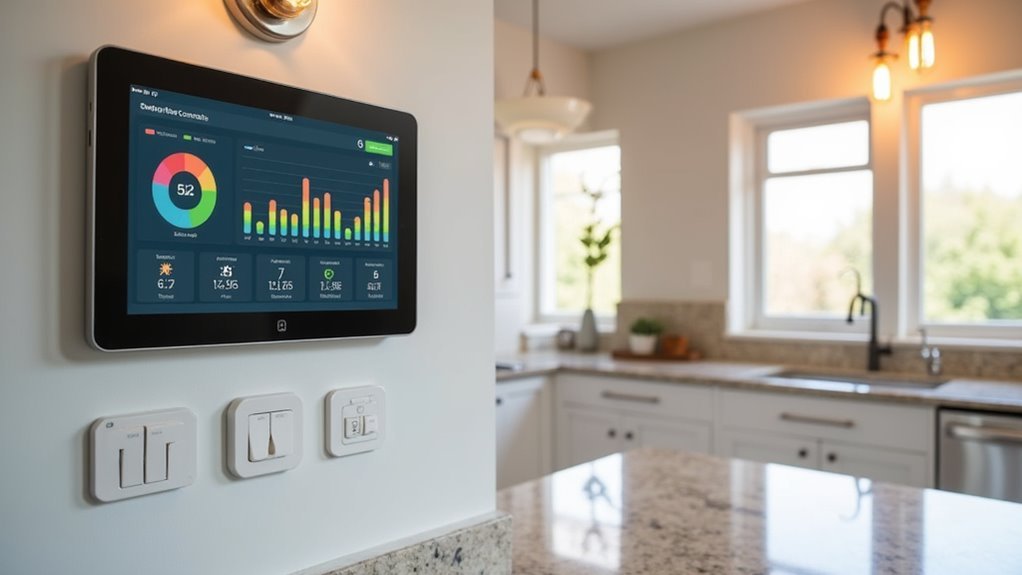


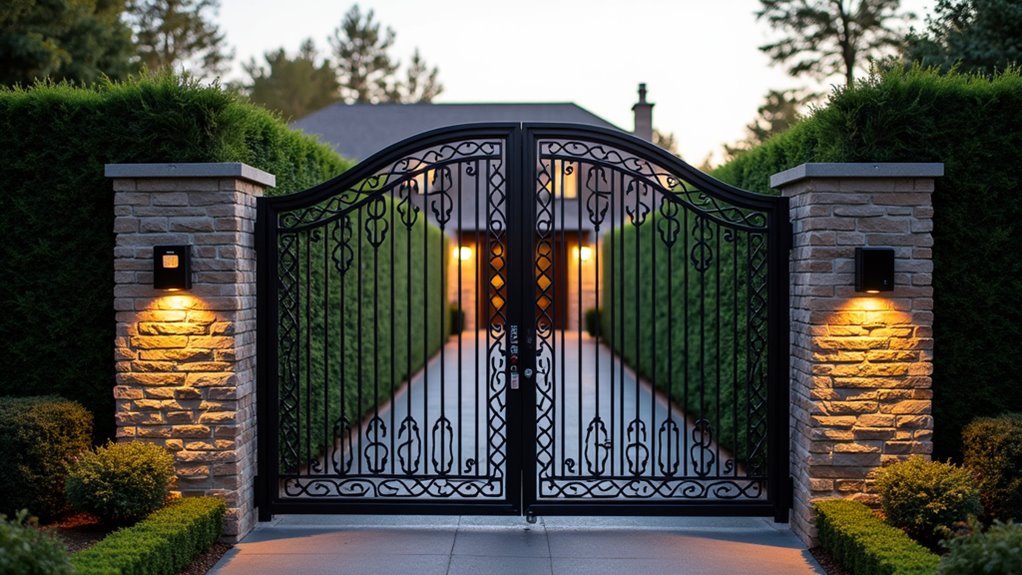
Leave a Reply